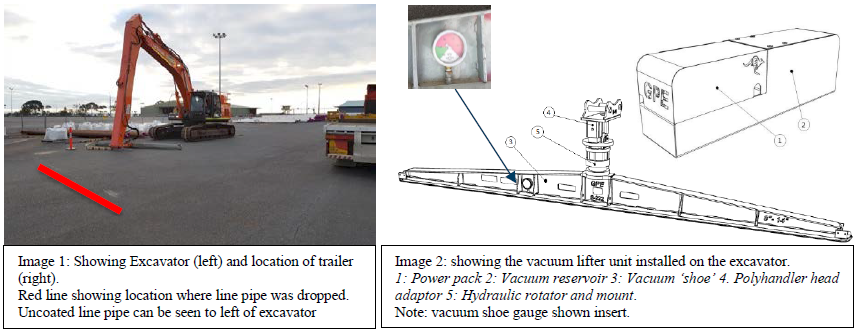High potential near miss: dropped line pipe after vacuum lifter failed
What happened?
During load out of a 30cm uncoated line pipe onto a transport trailer, the vacuum lifter unit being used to move the pipe lost suction and uncontrollably released (dropped) a 12m length of line pipe (weighing 1.8Te) from approximately 2m in height. This occurred as the excavator was slewing towards the transport trailer to load the single pipe length. No alarms were sounded, and no warning was provided to the excavator operator at the time of the incident. There were no personnel in the area during the lifting operation. The vacuum lifter requires no personnel interaction, other than the excavator operator (who is located inside the excavator cabin).
Had there been personnel in the area when the length of line pipe was dropped, it could have resulted in a high potential incident.
A positive finding was that all personnel were well away from the lift (not in the line of fire) and this was captured in the task risk assessment and recorded in morning pre-start meeting.

What went wrong?
- The vacuum seal on the ‘shoe’ was worn out after moving over 5000 lengths of line pipe. Half of the vacuum seal was replaced on the morning of the incident; this created a situation where the seal was neither effective nor consistent across the length of the pipe;
- A guide tab was missing from the head of the unit which helps the operator align the vacuum shoe across the apex and centre line of the line pipe; this may have caused the unit to seal a few degrees outside of parallel along the centre line and contributed to the sudden loss of suction pressure;
- There was no routine testing done to ensure the vacuum unit was holding pressure;
- A full maintenance schedule was not provided by the equipment supplier.
What lessons were learned?
Our member notes that vacuum lifters are common devices and used extensively to move various types of pipe. However, as with all lifting devices, all personnel must remain well clear of loads and always consider that the load could move and/or drop.
- Ensure that personnel operating vacuum units have a full understanding of required maintenance (daily, weekly and other) including replacement of consumables such as shoe rubber seals;
- When using lifting devices that use suction pressure to hold the load, daily tests should be completed to confirm integrity. Our member suggests a ‘ten for ten’ test, where the load is held for 10 minutes to confirm no greater loss than 10% of pressure; this is a good example of verifying that the system is working as intended;
- Regular maintenance should verify that alarms function and work at correct levels for the work scope. In this instance, the alarms were function tested during the pre-start but did not sound during the event.
Members may wish to refer to:
Safety Event
Published: 13 February 2019
Download: IMCA SF 02/19
IMCA Safety Flashes
Submit a Report
IMCA Safety Flashes summarise key safety matters and incidents, allowing lessons to be more easily learnt for the benefit of all. The effectiveness of the IMCA Safety Flash system depends on Members sharing information and so avoiding repeat incidents. Please consider adding [email protected] to your internal distribution list for safety alerts or manually submitting information on incidents you consider may be relevant. All information is anonymised or sanitised, as appropriate.
IMCA’s store terms and conditions (https://www.imca-int.com/legal-notices/terms/) apply to all downloads from IMCA’s website, including this document.
IMCA makes every effort to ensure the accuracy and reliability of the data contained in the documents it publishes, but IMCA shall not be liable for any guidance and/or recommendation and/or statement herein contained. The information contained in this document does not fulfil or replace any individual’s or Member's legal, regulatory or other duties or obligations in respect of their operations. Individuals and Members remain solely responsible for the safe, lawful and proper conduct of their operations.
